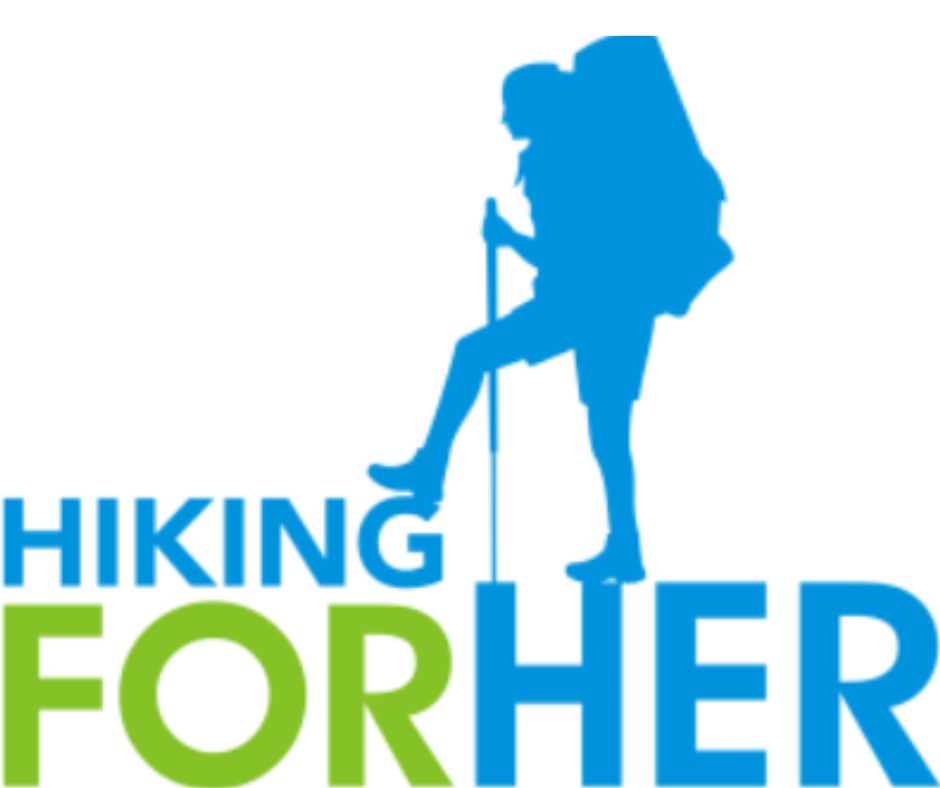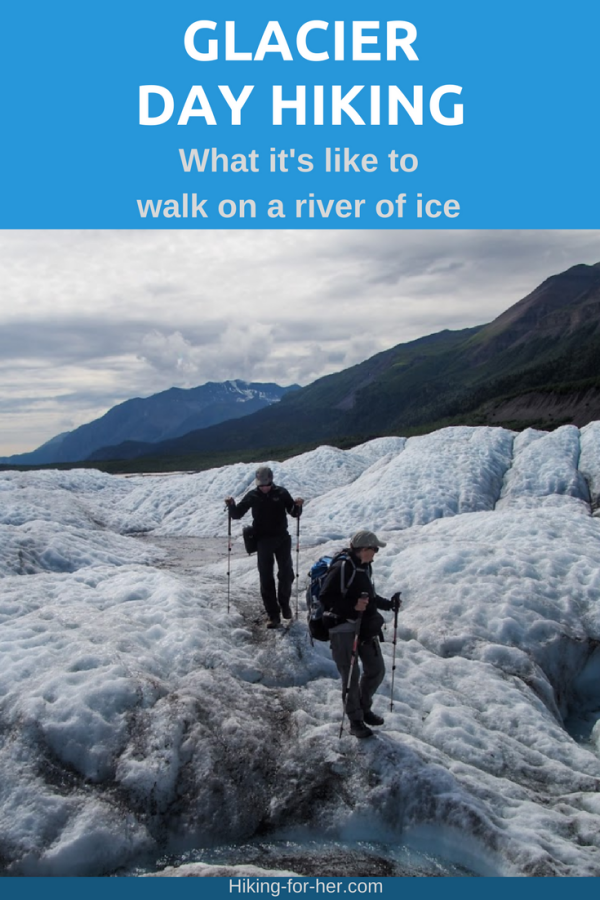Glacier Day Hiking Experience:
All I Can Say Is Wow!
By Diane Spicer
These glacier day hiking tips are meant to give you an accurate picture of what it's like to step onto a glacier and spend time exploring it.
The limited amount of time I spent on this particular glacier lends itself more to the term glacier walking.
And for the record, I'm no expert on this type of hiking.
These tips are a compilation of my own brief experience with one river of ice in Alaska's Wrangell St. Elias Park, and do not reflect conditions in all parts of the world.
My experience spanned four hours on a dry, calm July day.
- This is simply an eye witness report, to whet your appetite for safe glacier day hiking.
Photo credit: All photos by Rhane Pfeiffer and David Midkiff
Safety disclaimer
Do not attempt glacier hiking without an experienced guide and the proper equipment.
The hazards and pitfalls of this type of hiking are outlined in these glacier hiking tips to acquaint you with this unique type of hiking.
But Hiking For Her is not responsible for any decisions you make about glacier travel after reading this trip report.
Glacier hiking on an
Alaskan glacier: Nizina
Wrangell St Elias National Park and Preserve (southeast Alaska) is blessed with a multitude of glaciers.
The glacier I explored was the Nizina Glacier, accessed via bush plane from the town of McCarthy.
- Plus a long, rocky hike to its terminus.
My guided exploration was part of a 12 day base camping trip in the Wrangells, July 2017.
- You can read my full Wrangell St Elias trip report here. (coming soon)
- Or my Wrangell dayhiking tips here.
Three of us hiked a big loop around the relatively flat terminal area of the glacier, so did not need to use crampons or ice axes.
We did use trekking (hiking) poles and had sturdy soled hiking boots on our feet.
If it had rained recently, we would not have tried to access the glacier due to unstable surfaces around the access point and potentially hazardous slick, icy surfaces.
Glacier day hiking vocabulary primer
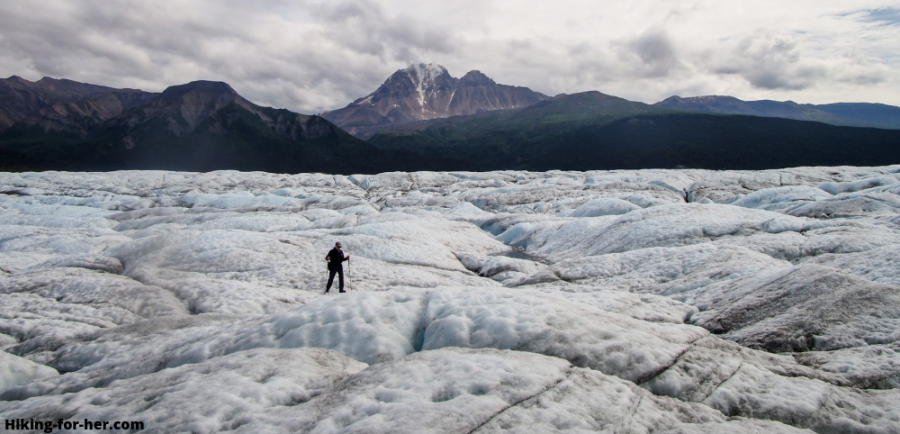 That's a whole lotta glacier to explore!
That's a whole lotta glacier to explore!Geology has its own language, and you will need some toothy words to understand this glacier day hiking trip report.
Formations and features of a glacier are outlined below from a lay person's (my) perspective:
- Glacier: a long lasting deposit of ice and snow on land which is being pulled by gravity so it flows (slowly)
- Glacier terminus/nose: where the ice ends, and perhaps a lake is formed
- Terminal moraine: a pile of rocky rubble which marks the furthest point the glacier achieved
- End moraine: similar idea, but marking the recent retreat(s) of the glacier
- Lateral moraine: piles of rocky loose rubble on the sides of the glacier; may be used to access the glacier itself
- Crevasse: a deep open crack on the surface of the glacier caused by tension (pulling apart forces); easy to see in summer conditions; to be scrupulously avoided
- Moulin: a crack running in the upslope/downslope direction with respect to the surface of the glacier; when water flows into these cracks you'll hear a loud, exciting roar
- Glacial lakes and streams: melting water has to go somewhere!
- Blue ice: a rich blue color because water molecules are reflecting visible light's blue wavelengths to your eyes and all of the air bubbles have been squeezed out beneath immense pressure from the ice layers
- Rock flour: pulverized rock from the glacier in surface water, giving it a milky appearance and a wide range of blue hues
Just for the record, the Nizina Glacier is a temperate glacier, with frozen and liquid water during warm summer months.
The Malaspina Glacier, which can be accessed elsewhere in the park, is a piedmont glacier: it terminates at the ocean.
Want more glacier words?
- For an exhaustive glacier glossary, use this.
Now you're ready for the description of my glacier hiking adventure!
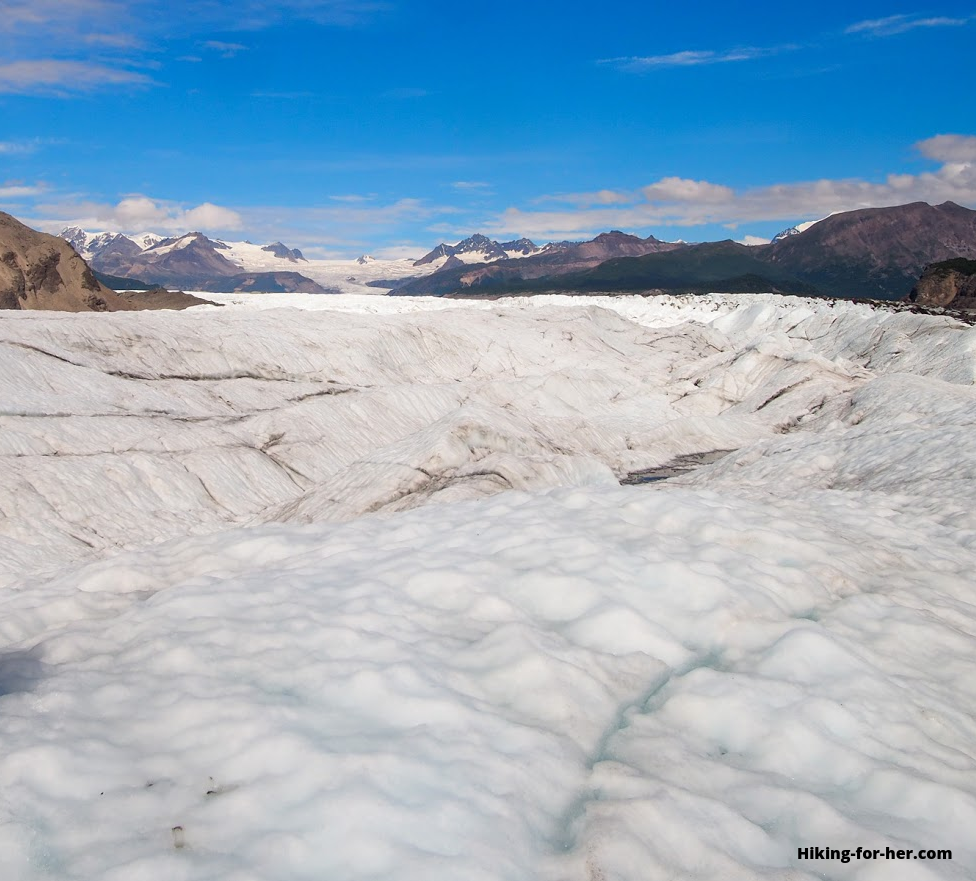 Looks deceptively easy, doesn't it! But keep a sharp eye out for surface water, crevasses, and slick spots.
Looks deceptively easy, doesn't it! But keep a sharp eye out for surface water, crevasses, and slick spots.Getting onto the glacier
A big problem in glacier day hiking is how to get onto a glacier, which sits higher or lower than your access point.
We solved the problem by hiking for a quarter mile on a lateral moraine, looking for a safe spot to access the glacier itself.
A few cautionary notes about this type of approach:
- Rock fall is common in this area, especially after the sun has had a chance to start warming up the rocks.
- Unstable ground may surprise you when you put your weight on it.
- Sun protection for eyes and skin is important to shield yourself from the UV rays bouncing around.
The glacier had relatively few crevasses where we were exploring (good beta from our guide Rhane), all of which were easy to spot from a distance.
Due to the warm cloudless weather, there were a lot of glacial rivers, streams and rivulets to cross or avoid.
- Throughout our hike, we were treated to deliciously pure glacial melt (actually, carefully aged H2O molecules finally liberated from the ice) in our water bottles!
Some new hiking tricks to learn
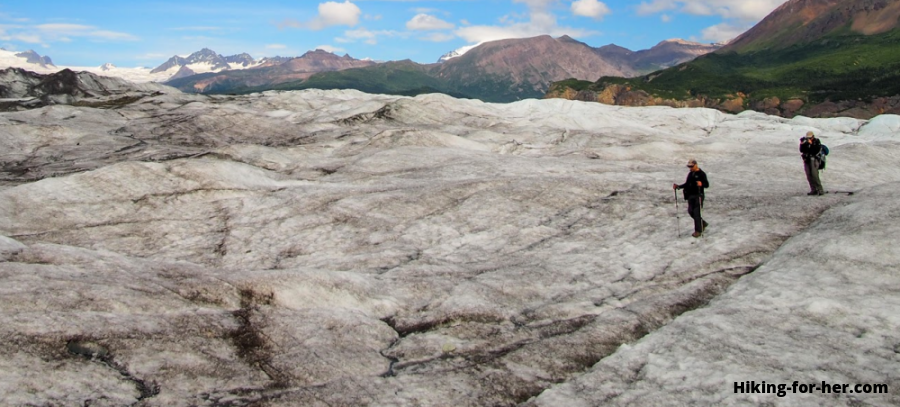 The dirty surface of the glacier means you stay upright as you walk.
The dirty surface of the glacier means you stay upright as you walk.As a hiker, you've trained yourself to either avoid ice, or tread carefully when you have to traverse it.
On a glacier, you can walk confidently on ice!
But you need to be sure you've picked a relatively dry time to step onto it.
- Recent rain will slick up the ice and create treacherous walking conditions unless you wear crampons.
Your first few steps on the glacier will probably be tentative."Will I fall?"
Then your brain switches over to "This is amazing!!!" and you can truck along at whatever speed the terrain and your curiosity permit.
On a relatively flat glacier, crampons would just get in the way of exploration.
- As soon as you try to ascend or descend a steeply sloped glacial surface, they become vital for your safety.
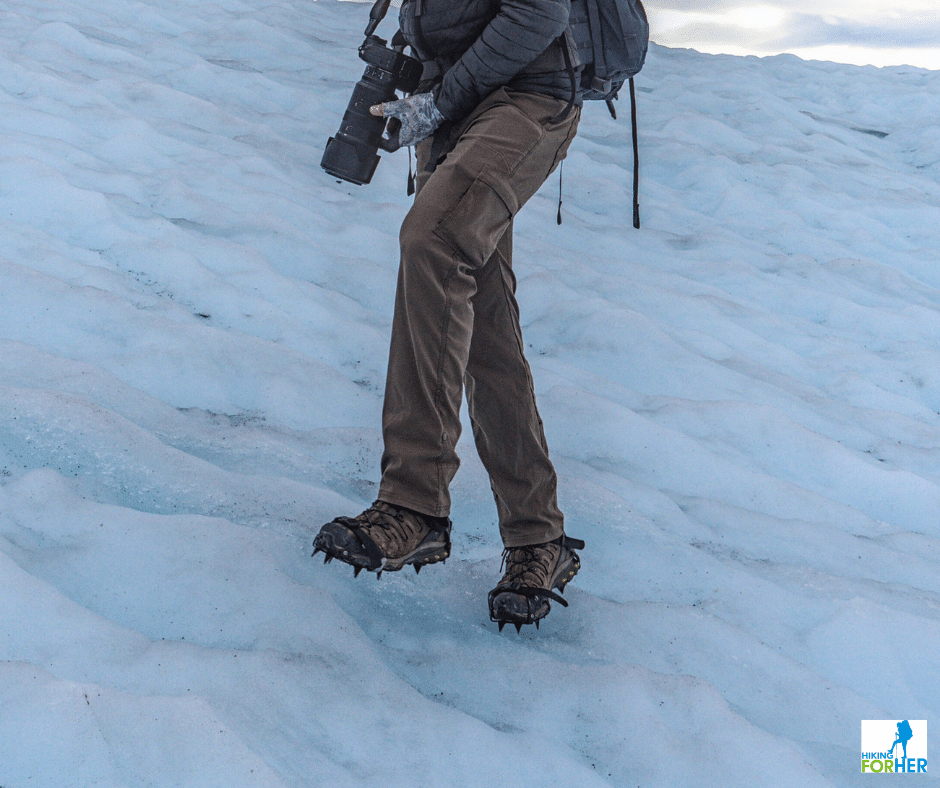 Wearing tiny steak knives on your feet is one way to get a grip on a glacier.
Wearing tiny steak knives on your feet is one way to get a grip on a glacier.
As mentioned, we did not wear crampons on this glacier.
It really helps navigation if you've had a chance to fly over the glacier first.
- This was possible at the Nizina Glacier, because we camped at the glacier's Nizina Lake (pooled glacial melt water that creates a river at the outlet) after a fly over to scope out the landing strip.
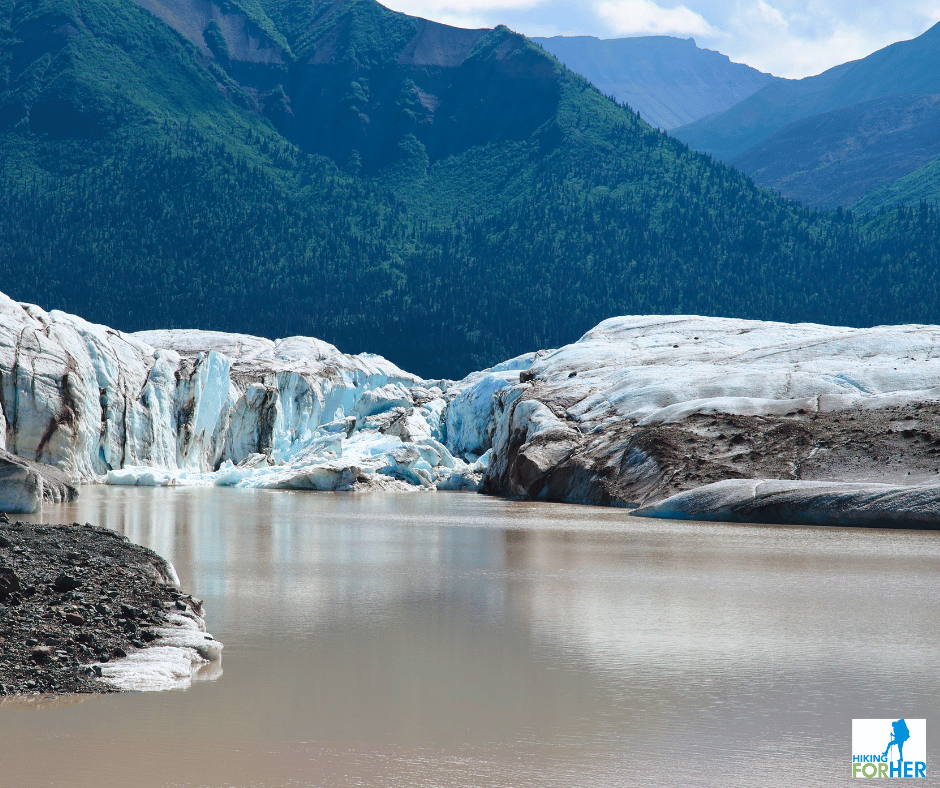 Nizina Glacier and Nizina Lake at its terminus
Nizina Glacier and Nizina Lake at its terminus
Why glacier day hiking is amazing
Any time I can learn a few new hiking tricks, I jump at the chance.
No jumping on the glacier was involved, but I certainly came away with a whole new appreciation for the power of hydrogen, oxygen, and cool temperatures!
I also enjoyed the creaks, grumbling, burbling and splashing noises coming from the glacier. Like nothing I'd ever experienced!
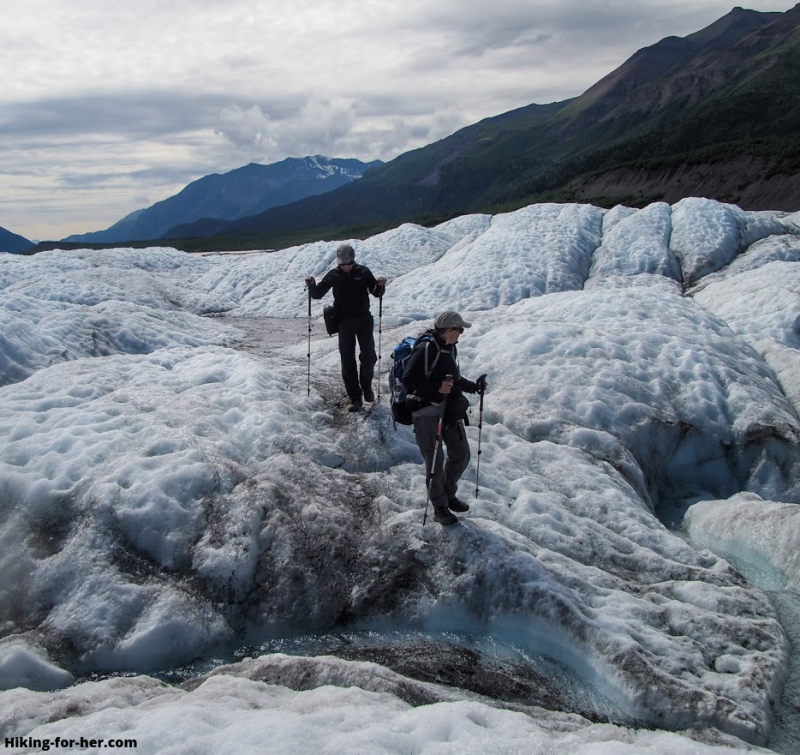 Surprisingly easy to keep your grip, thanks to dirt and debris under your boots. Note the glacial river in the foreground, making a lovely sound.
Surprisingly easy to keep your grip, thanks to dirt and debris under your boots. Note the glacial river in the foreground, making a lovely sound.Will I try it again?
Definitely!
And you should, too!
- New skills, new vocabulary, and a new way to explore Mother Earth, what are you waiting for?
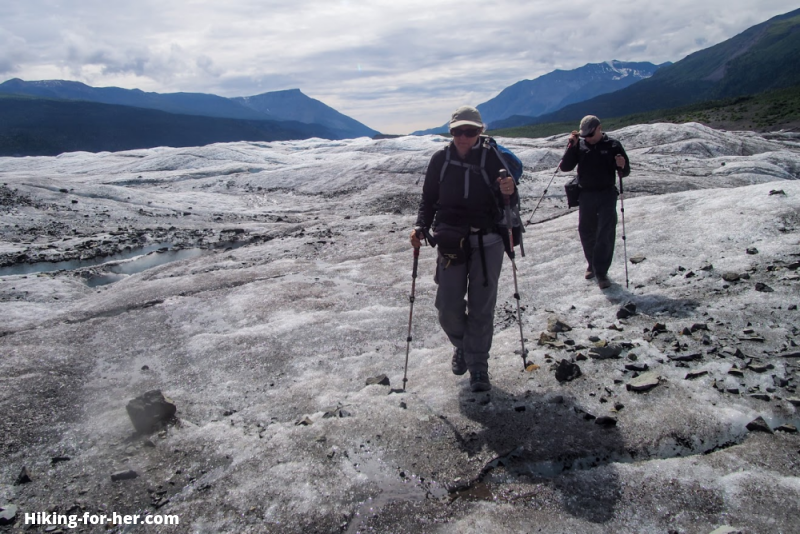 So much to see, and lots of daylight hours in July's Alaska summer for a long day of exploring the Nizina Glacier's surface
So much to see, and lots of daylight hours in July's Alaska summer for a long day of exploring the Nizina Glacier's surfaceIf you're headed into the backcountry for some glacier day hiking, my Wrangell St. Elias gear checklist might be helpful :)
Glacier Day Hiking Tips
|
I get emails all the time about what I wear, eat, carry and love to use on the trail. That's
why I provide affiliate links to you: the best gear that I use myself and have seen used by other hikers is instantly
available for your consideration, and the gear company sends a few
pennies per dollar to this reader-supported hiking website. There is no added cost to you! Everyone ends up a winner: Great gear for you, strong gear companies, and more free hiking tips for everyone. Thanks very much for your support. It's warmly and sincerely appreciated. It also helps send these hiking tips to all your virtual trail buddies around the globe. |
 |
